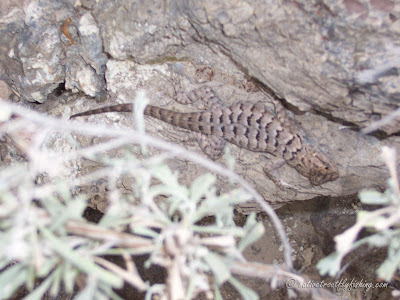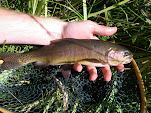Day 1: Monday June 26th 2006: My dad and I left home bound for eastern Oregon around noon with the hopes that by the end of this trip I would manage to catch some Harney-Malheur Basin Redbands, Columbia Basin Redband and Whitehorse Basin Cutthroat. Other than some extremely high temperatures (109 degrees F in Gresham Oregon), the first day was rather uneventful and we ended up staying the night at my uncle's house in Bend Oregon.
 |
The Three Sisters and Oregon Cascades from my uncle’s house in Bend
|
Day 2: Tuesday June 27th 2006: This was to be the day for me to do the majority of my fishing; we drove from Bend to the small town of Burns where we purchased our fishing licenses. The next stop was a river in the Harney-Malheur Basin to try to catch some Redbands. We arrived at the river in the mid-morning, set up camp and I got to fishing. |
| The river |
To get away from the campground, I decided to hike upstream a ways. Upon entering the river, the water was a bit high and off colored from snow melt, but luckily that did not stop the fish from feeding. I decided to start with a dry/ dropper river and began to catch fish on a Royal PMX and Lightning Bug set up almost right away. These Redlands were some extremely hard fighting fish, and the first one I hooked jumped four times before finally coming to the net. With the high flows, it seemed that the majority of the fish were keyed in on nymphs, but I caught a few on dries as well. In a few hours of fishing, I managed to catch a fair number of fish, but lost far more including an 18" Redband that I hooked on a streamer in one of the deeper pools and almost had to the net before it tossed the fly.
 |
| A Harney-Malheur Basin Redband |
 |
| Another view of the river |
After finishing up fishing and returning to camp, a large thunderhead was moving in and with extremely bad mosquitoes, we made the choice to go ahead and skip camping here and continuing on to our next destination in the Whitehorse Basin to fish for some Cutthroat. Oregon south of the Steens Mountains is extremely sparsely populated and we drove for over an hour without seeing any oncoming traffic. The road to the stream that I planned on fishing in the Whitehorse basin lead us up Trout Creek in the Alvord Basin which was once home of the now extinct Alvord Cutthroat; a victim of hybridization with introduced Rainbow Trout.
 |
| An old homestead along Trout Creek, the former home of the Alvord Cutthroat Trout |
We arrived at the creek and I started catching fish almost as soon as I started fishing. The first fish that I hooked was an impressive about 15" Cutthroat which managed to shake the size 18 nymph just before I could net it. Once I figured out that this creek was going actually to produce some fish, I took a quick break and we went ahead and set up camp and make some dinner. As I took in my surroundings, I was amazed by the amount of life found along the creek in this parched country, far from civilization. On the walk back to the creek I had a deer run across the road in front of me, and there were jack rabbits scurrying around in every direction.
A small waterfall on the creek
 |
| A streamside lizard |
Once I got back to fishing, I found that the fish were especially susceptible to small black nymphs and most good pieces of holding water held a Cutthroat. I fished until dark and caught a good number of Whitehorse Basin Cutthroat, many of which seemed very resistant to letting me photograph them.
 |
| A Whitehorse Basin Cutthroat |
Day 3: Wednesday June 28th 2006: After getting up, I went back to the creek to do a bit more fishing. However, overnight there had been some thunderstorms upstream, which had raised the flows and colored the creek up a bit and put the fish down. Despite this a little ways upstream I was able to find a series of beaver ponds, and using a Zug Bug nymph I was able to catch a few more fish.
 |
| Looking at the creek from the top of a ridge |
 |
| Me at the Whitehorse Basin stream |
After leaving the creek we headed to Winnemucca, Nevada and got hotel room for the night to rest and regroup for the drive home.
Day 4: Thursday June 29th 2006: We left Winnemucca and headed to northeastern Oregon to catch some Columbia Basin Redband, however this time luck was not with me as all of the rivers in this area were blown out from thunderstorms and snow melt. We decided to camp on the Lostine River, as it was one of the few areas that we found were it was not raining.
 |
| The Lostine River valley |
Day 5: Friday June 30th 2006: When we got up in the morning, the rivers were still blown out and way to high to fish, so we cut our losses and headed home with an uneventful 6 hour drive home.























3 comments:
That is neat country in that area. I have been in it many times. I have been wanting to fish the dunder und blitzen river ever since my last time through the steens. The steens are a must see.
Http://onlineflyfishingguide.com
As a child I was able to fish "Three Mile Creek" (Now Closed Since 1990)and "Home Creek" (No Trout left). Great photos of Blitzen and Trout Creek, how bad were the mosquitos and Mayflies hatches? Did you try to fish "Mann Lake, Fish Lake, Crumbo or Rock Lake?" Once upon a time, this region had more trout, deer, chuker, quail, sage grouse than you could imagine. A hidden gem was "Blue Lake" in this region, oh the memories your photos bring!
I have to ask where it was you found that little stone cabin with the roof rotting away? That thing is absolutely beautiful!
Post a Comment